
The European market potential for gap year tourism
Gap year tourism is dominated by the youth travel market – recent secondary school and university graduates and young people taking a career break. These travellers look for authentic, stimulating travel experiences, often including volunteer work and adventure. Gap years originated in the UK and are now a well-established concept. They are becoming more popular across the European market of 73.6 million young people excited about the idea of travelling abroad. Immersive adventures, sustainable travel and living like a local are key trends for young gap year travellers.
Contents of this page
1. Product description
People usually take a gap year after graduating from secondary school or university, using their time off to travel, work or plan the next stage of their life. People aged 18-25 are more likely to take a gap year than other age groups. Older people are also taking gap years. They may be taking a career break, a sabbatical or an extended long trip.
A gap year is not always exactly one year – typical duration ranges between 3 and 24 months. In the UK, gap years have been a popular option for students for decades. In continental Europe and North America, taking a gap year has also become more common. What people do in their gap years varies. A survey conducted amongst UK ‘gappers’ in 2022 found that 56% of respondents chose to go travelling. A further 16% chose to volunteer abroad and 16% decided to work abroad.
Figure 1: What do people from the UK do during their gap years?
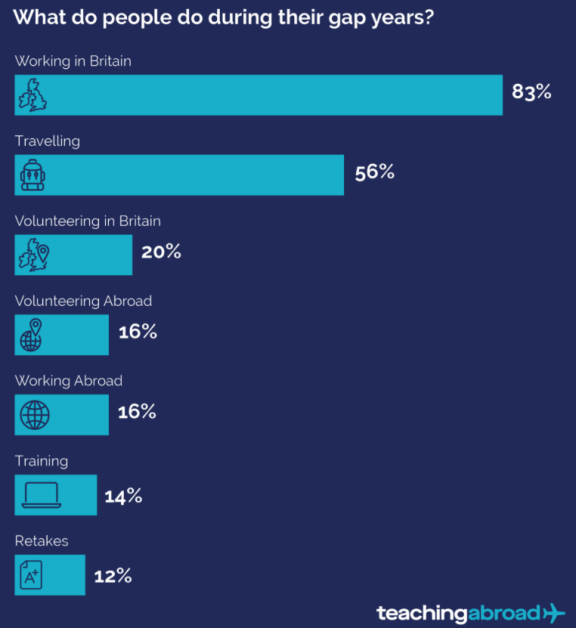
Source: Teaching Abroad Direct
Gap year tourism usually involves three main types of travel experiences:
- Work experience placements: work experience placements are also referred to as internships. They are common in the fields of medicine (nursing, public health, nutrition, occupational therapy), journalism, finance, teaching and law. This category also includes learning experiences, such as learning a new language or training to be a park ranger.
- Volunteer placements: volunteer placements involve a wide range of activities. Amongst gap year travellers, the most popular activities are in the fields of marine conservation, wildlife conservation and working with children. Community projects are also popular. Examples include construction/rebuilding projects, teaching English as a foreign language, working with elderly people, healthcare initiatives, business development and horticultural projects.
- Adventure travel: guided/planned adventure trips taken by gap year travellers are usually managed by specialist gap year companies. They often involve a wide range of adventure activities, such as hiking, ziplining, rafting, canoeing, horse riding, cycling, sightseeing and so on. These trips may or may not involve volunteer work, as described above. Other gap year travellers prefer to arrange their trips independently and make their own decisions about what activities they want to do. Independent young travellers are often referred to as backpackers.
Examples of gap year experiences
The market for gap year experiences is substantial. There are many tour operators that specialise in gap year trips. General tour operators may also cater for gap year trips or young travellers, alongside other travel themes. The table below gives an indication of the wide range of opportunities for gap year tourism.
Table 1: Examples of gap year experiences on the market
| Work placements | Duration | |
| Medical internship in Peru | Learn from professional doctors and nurses at a hospital or health centre. Gain practical experience conducting health checks and giving educational talks in local communities. Suited for medical elective students. | 4 to 52 weeks |
| Human rights internship in Ghana | Work for the Ghana police helping victims of domestic abuse and preventing violence against women and children. Support the local community and take part in outreach work and campaigns. Explore the countryside at the weekends and meet other interns from all over the world. | 1 to 52 weeks |
| Journalism internship in Mongolia | Work with experienced print media journalists and learn about the different types of journalism. Live in Ulan Baatar with a host family; explore the country at the weekends. | 2 weeks to 3 months |
| Volunteer placements | ||
| Giant tortoise and sea lion conservation in the Galápagos Islands | Live in the Galápagos Islands as a conservation volunteer, caring for giant tortoises and planting tree saplings. A unique opportunity to learn, help and explore. Stay on San Cristóbal Island and live with other volunteers in shared accommodation. | 1 to 12 weeks |
| Giraffe and lion conservation in Kenya | Help conservation experts protect threatened wildlife in Kenya. Work with endangered Rothschild giraffes and lions in a conservancy and help stop the decline of local giraffe populations. | 1 to 52 weeks |
| Protecting sea turtles in Costa Rica | Live on a beautiful Costa Rican beach. Protect the turtles that nest and hatch in the sand. Live like a local and make a real contribution to marine conservation. | 1 to 24 weeks |
| Volunteer sports coaching in South Africa | Coach football, netball, hockey, cricket, rugby, tennis, basketball or swimming in some of Africa’s poorest townships. | 5 to 12 weeks |
| Zambia community volunteers | Help build homes in Zambia using traditional techniques to provide better living conditions for children. Help teachers at local schools and nurseries. Learn about local village culture. Optional trips include a four-day safari in Botswana and a visit to Victoria Falls. | 14 to 28 days |
| Wildlife research in South Africa | Travel to a private reserve in South Africa and live alongside an international research team doing essential wildlife conservation work. Optional activities include learning to make a local dish, exploring medical uses of indigenous plants, discovering basic bush survival techniques, enjoying a night sky safari and developing wildlife photography skills. | 1 to 12 weeks |
| Madagascar lemur and wildlife conservation expedition | Help protect critically endangered lemur species in a primaeval tropical rainforest. Trek through the forest, night and day, to do a census of lemurs, tiny frogs or chameleons.
| 2 to 12 weeks |
| Adventure trips | ||
| Thai adventure | Feed and bathe elephants for an ethical elephant project, sleep in a traditional Thai ‘float house’ in Khao Sok National Park. Jungle trekking and bamboo rafting, kayaking in mangrove forests. | 18 or 25 days |
| Central American journey | Guided group tour of seven countries: visit Mayan ruins at Tikal, Guatemala, do a traditional homestay in Nicaragua, relax on black sands in El Salvador, enjoy reggae bars in Belize, and spot monkeys and sloths in the cloud forests of Costa Rica. | 32 days |
| Southeast Asia experience | Travel through Thailand, Laos, Vietnam and Cambodia: watch the sunrise over Angkor Wat and visit the ‘Tomb Raider’ temple, feed and bathe elephants in Chiang Mai, take a cruise in Halong Bay, river tube in Vang Vieng and snorkel with phosphorescent plankton. | 31 or 33 days |
| Amazing Asia: India to Indonesia mini gap | Explore the Asian continent and visit India, Nepal, Thailand, Malaysia and Indonesia. Involves guided elements and independent travel using a flexible travel pass. | 85 days |
| Learn Spanish, dance and experience adventure in Havana and Viñales, Cuba | Immerse yourself in Cuban culture in Old Havana and Viñales. Learn Spanish and take dance classes, go on cultural tours and experience adventure.
| 2 to 4 weeks |
| Combination of adventure and volunteer work | ||
| Africa mini gap: volunteer and explore | Immerse yourself in the culture and wildlife of Africa. Take part in two volunteer projects and explore the local landscapes on an overland adventure. Do volunteer work at a local Zambian school and travel through Botswana, Namibia and South Africa. Work for a wildlife conservation project in Kruger National Park and help protect the Big 5. | 54 days |
Source: Acorn Tourism Consulting
End-market segmentation
There are five groups of gap year travellers. Overall, the gap year market is dominated by young people between the ages of 18 and 30.
- Secondary school and university graduates: these young people either defer their place at university to take a gap year once they have finished university. Waiting a year before enrolling in university is the more popular option, which means that these travellers are typically between 18 and 20 years old. They are young and relatively inexperienced. Their parents still play a key role in their lives and often support them emotionally and financially during their gap year.
University graduates are a growing market. This is because it is taking them longer to find work after university, giving them the opportunity to travel. - Young professionals and career breakers: young people take career breaks for many reasons. They may want to change careers or develop new skills, or they may be unemployed. Some employers offer their employees long periods of unpaid leave, known as sabbaticals. This group is more likely to use their skills to do volunteer work (or other unpaid work) and is therefore very valuable to the volunteer sector. Young professionals and career breakers are broadly aged between 25 and 35.
- Backpackers: this group largely overlaps with the first two groups. Backpackers are usually independent budget travellers. An estimated 45 million backpacking trips are taken every year.
Figure 2: Who goes backpacking?
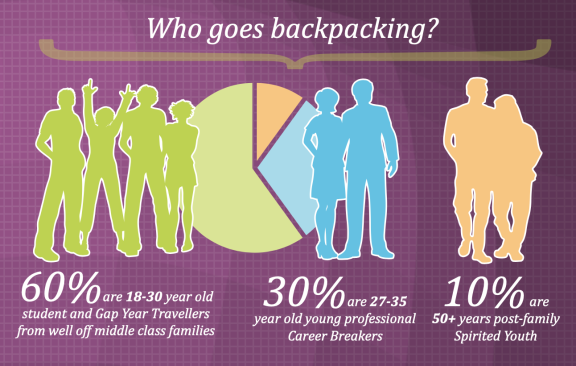
Source: Acorn Tourism Consulting
- Families: a small segment in this niche are families who take their young children out of school and travel overseas for extended periods to give their children a ‘life education’. This may also involve volunteer work to get a real taste of a different life. Have a look at the travel adventures of this French family as they travelled between Bogotá, Colombia, to Rangoon, Myanmar, over a one-year period.
- 50+ market (‘grey gap year’): these are often ‘empty nesters’ with no children at home, and this group also includes retirees. They have more time and money to travel and represent a growth market for the tourism industry as a whole. 50+ travellers seek unique and immersive experiences as they age, and they are keen to try new things. The golden gap year: why the 50-plus generation are setting off the see the world, an article published by National Geographic, gives some interesting insights into what motivates older people to take a gap year.
Tip:
- Research the SAVE (scientific, academic, volunteer, education) market, as there is lots of overlap between gap year and SAVE tourism. Both are dominated by the youth travel market. To find out more about the SAVE market and to see whether you can align your tourism offer with a broader market, read the CBI study What are the opportunities in the European SAVE tourism market?
Motivations to take a gap year
Finishing secondary school is widely regarded as the moment someone becomes an adult. This typically happens around the time you turn 18. In most European countries, this is the age you can vote, get married, leave home, drive a car and so on. The desire to be more independent and take a break from studying to find your place in life is therefore a key motivation for taking a gap year. Travelling and working are the most popular routes to becoming more independent.
Figure 3: Why do people take a gap year?
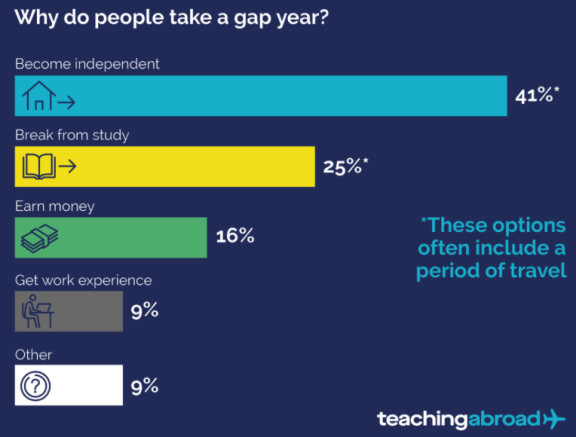
Source: Teaching Abroad Direct
It has become accepted practice in Europe to take a gap year between graduating from secondary school and enrolling in university. Research has shown that there are benefits for young people who take time off from studying:
- A gap year provides an opportunity to develop personal skills and experiences.
- A gap year helps young people become more mature before leaving home for university.
- 60% of those taking a gap year said it helped them decide which subject to study at university. They were able to use their experiences to inform their choice.
- 66% were more serious about their studies when they started university. They often found that they were able to settle into university life more quickly and easily.
- Future employers value CVs that include a constructive gap year. Travel experiences and productive employment show that someone has determination and purpose.
This YouTube video by UK tour operator Trailfinders is an example of gap year marketing that inspires young people to travel overseas.
Gap year tourism is dominated by the upcoming Gen Z consumer group
Gap year travellers are mostly Gen Z. They were born between 1996 and 2012 and are 11 to 27 years old today. They have distinctive characteristics, which will continue to develop as they become an influential consumer group:
- The first generation to grow up connected to technology, they are ‘digital natives’. They do not know life without digital devices and are connected 24/7. They get most of their information online and are very skilled at using devices for many needs – work, entertainment, social media, shopping and travel.
- They have been shaped by major developments such as globalisation, the 2008 global financial crisis, terrorism, climate change and the Covid-19 pandemic. They are acutely aware of the importance of sustainability and want to make a difference.
- Gen Z strongly values independence and flexibility and many have outspoken progressive beliefs around race, gender and LGBTQ equality.
- Gen Z is heavily influenced by images and videos; social media platforms are widely used. Instagram, Pinterest and TikTok are the most common sources of travel inspiration.
- Gen Z travellers consider their devices indispensable, using them to do research, book holidays, share experiences and so on. They demand seamless digital connectivity at all times.
- They are not a wealthy group of travellers and often have to save to afford holidays. But with fewer commitments, they have more time to travel. So they look for good value across the board, from transport to accommodation and experiences.
- As young travellers, they are resilient, and they are determined to travel no matter what. They are not overly concerned about economic problems, political unrest or epidemics. They have saved their money and they want to see the world.
- There is some evidence that they may take longer trips or look for work experience abroad if the economy in their home country is doing poorly, staying abroad until things improve.
To find out more about European Gen Z travellers, read the report Study on Generation Z Travellers.
Accessible tourism in the European market
Accessible tourism is the ongoing endeavour to ensure that tourist destinations, products and services are accessible to all people – regardless of their physical limitations, disabilities or age. It encompasses publicly and privately owned tourist attractions. Accessibility improvements not only benefit those with permanent physical disabilities, but also parents with small children, elderly travellers, people with temporary injuries such as a broken leg, as well as their travel companions. Disabled tourists may travel individually, in groups, with their family or with carers.
Accessibility and gap year tourism
Gap year travellers with disabilities are just as motivated to travel as any person without a disability. If you want to cater for this group, you must be very clear about what you can and cannot provide:
- Make sure you know what their needs are so you can be sure you can meet them. Remember that most disabilities are not visible, so do your research in advance.
- Be honest. For instance, if you know that it will take several hours to reach a destination and that there are not many places with suitable facilities to stop along the way, you must say so. Gap year travellers with disabilities will be very clear about what they can and cannot do.
- If you want to cater for this market, make a video about what you can do to help travellers with disabilities and post it on your website. That way, your guests can make their own judgements.
- If someone with a disability wants to do volunteer work, make sure the community they are volunteering with has suitable facilities. Help them put in place appropriate facilities if required.
- Have someone on hand 24/7 to help if there is a problem.
- Read the article 10 people on what accessible travel means to them. It offers lots of tips for travel providers to help them support guests with disabilities.
Tip:
- Read the CBI study What are the opportunities in the European market for accessible tourism? for practical and useful advice on how to make your tours accessible.
2. What makes Europe an interesting market?
The youth travel market (ages 15-29) is a very large segment of global travellers. It is estimated to account for 23% of all international tourism arrivals, according to the World Youth, Student and Educational Travel Confederation (WYSE) and the United Nations World Tourism Organisation (UNWTO). Its value grew from US$190 billion in 2009 to US$333 billion in 2018. Before the pandemic, it was estimated that 370 million youth travellers would account for US$400 billion in travel expenditure by 2020.
This growth is being driven by higher numbers of travelling young people, and by young people travelling more frequently. Major destinations like India report that inbound young travellers account for 27% of all arrivals. Before the pandemic, Sri Lanka also reported growing numbers of young travellers. As the global youth population continues to grow – it is estimated to reach 1.3 billion in 2040 – the expectation is that youth travel will grow as well.
Europe has a substantial youth population of 73.6 million. In 2021, young people aged 15-29 accounted for 16.3% of Europe’s total population (not including the UK). This is expected to decline to 15% by 2050. Overall, ageing populations across Europe are contributing to the market decline.
Source: Eurostat, ONS
Young Europeans are active travellers. In 2015, 66% of European residents aged 15-34 travelled for leisure reasons compared to 60% of those aged over 35. On average, young Europeans went on 2.6 trips a year, although these trips tend to be shorter (4.8 nights per trip) than those taken by older travellers (5.5 nights). Domestic destinations are the top choice for young European travellers, accounting for 75% of trips, followed by other European countries (19%).
Although countries outside the EU accounted for only 6% of trips, this does mean that 4.4 million young Europeans travelled outside Europe. There is good potential for tour operators to attract this group of enthusiastic young travellers, who are highly motivated to enjoy a once-in-a-lifetime trip to an exotic destination.
Research by Opodo has shown that sabbaticals (taking time off from work) are popular amongst Europeans. 71% would consider taking a sabbatical if it were an option. The 18-34 age group demonstrated the most interest in taking a sabbatical.
Figure 5: Taking a sabbatical from work
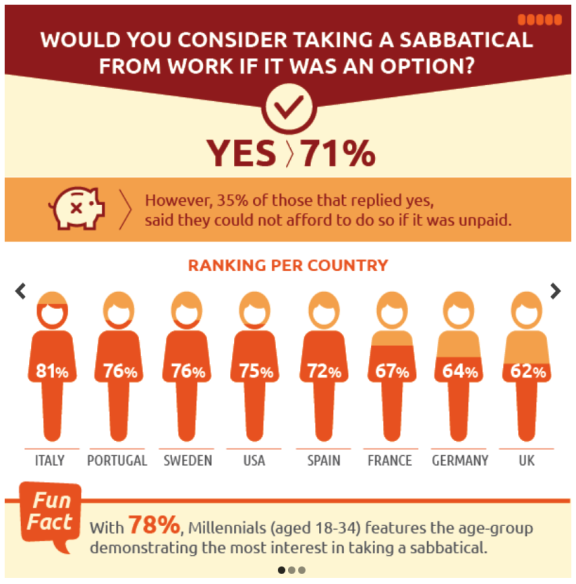
Source: Opodo
The research revealed interesting results from European markets:
- German and Spanish respondents believe that taking a sabbatical would make them more employable (60%). This figure is higher than the global average.
- Swedish people are the most likely to take a sabbatical to learn a new skill or take a course (30%).
- Spanish people are the most likely to learn a new language (23%).
- French people are the most likely to live in another country (25%).
In most European countries, there are no laws governing sabbaticals or career breaks. Some companies have a sabbatical policy, while others handle sabbatical requests on a case-by-case basis. Sabbaticals are usually only offered to employees who have worked at a company for many years. To find out more about sabbaticals and why Europeans like to take them, read the article What Is Sabbatical Leave? Everything You Need To Know.
Tip:
- Visit the WYSE Travel Confederation website for more information about the youth travel market. WYSE is a global membership organisation that represents the youth travel industry. It helps to promote and develop opportunities for the market. It also provides support to suppliers. You can consider becoming a member so you can attend the annual WYSTC conference to network with European buyers.
3. Which European countries offer the most opportunities for gap year tourism?
The leading European country for gap year tourism is the UK. Other European countries where gap years are popular are Germany, France, the Netherlands and Italy. There is also a strong gap year culture in the Scandinavian region (Denmark, Norway and Sweden).
United Kingdom
In the UK, there are 12.2 million young people between the ages of 15 and 29. This represents 18.1% of the total population, which is almost one in five people – a substantial market.
In 2022, between 181,500 and 185,200 young people between the ages of 18 and 24 took a gap year. Of this group, between 101,640 and 103,712 (around 56%) spent some time travelling during their gap year. Further research shows that 26% of the UK population have taken a gap year and 15% have taken a work sabbatical.
Figure 6: Gap years and sabbaticals in the UK
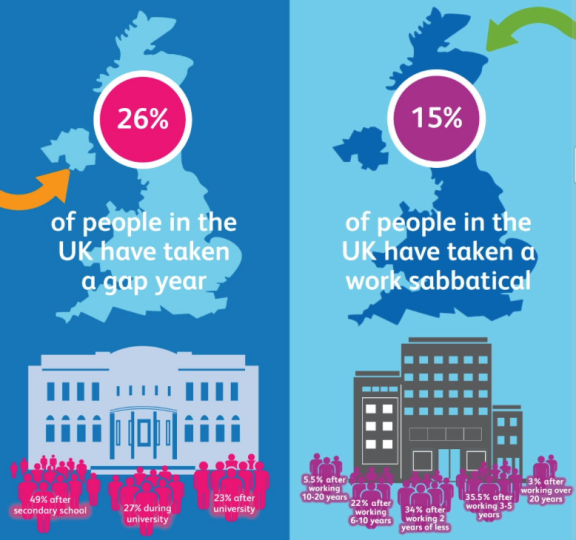
Source: Netflights
The most popular countries for British gappers are in Southeast Asia, particularly India, Thailand, Vietnam and Cambodia. Australia’s one-year working visa has also attracted many gap year students over the years.
UK gap year travellers often follow a well-worn backpacker trail through Southeast Asia, which has contributed to the ongoing popularity of these countries amongst this market. South America is also becoming a popular destination, especially Costa Rica, Peru and Argentina. These are good destinations for travellers who want to do volunteer work and those looking for adventure.
British Gen Z-ers are the most ethnically diverse age segment of the British population. They tend to support progressive ideas and activism related to diversity and equality. 58% of British Gen Z-ers believe that making a contribution to society is important. They are concerned about job insecurity and lack of career opportunities, and mental health is an important issue for them. British Gen Z-ers are tech savvy, spending half their time connected online.
Figure 7: Working with children is a popular activity for gap year tourism

Source: Image by Cheng from Pixabay
Immersive travelling experiences are important to British Gen Z-ers. They are particularly drawn to urban culture (75%), trying locally produced food and drink (82%), enjoying cultural activities (75%) and visiting places and learning about historical events (65%). They also like attending local cultural events (57%). Online travel agents (OTAs) are the preferred booking channel for UK Gen Z – they use OTAs to book flights (40%), local transport (34%), accommodation (47%) and leisure activities (37%).
There is no law that obliges companies to offer sabbaticals in the UK. Some companies offer them as a work benefit, others may consider them for their employees, depending on the circumstances. Nevertheless, 62% of Britons would be keen to take a sabbatical if it was an option, and if it was financially viable.
Germany
Germany has 13.2 million young people aged 15-29, representing 15.9% of the total population.
Germany has a long-standing culture of young people travelling abroad for long periods. There is also a strong culture of ‘global citizenship’ that contributes to the desire to volunteer abroad. The German education system is relatively flexible. Students are able and encouraged to travel and volunteer before, during or after their studies, and to do internships during their studies.
The wider German-speaking youth travel market includes Austria and Switzerland. Many German tour operators have offices or representatives in these countries. The Swiss market is small but important, as the Swiss are high-income earners and are less concerned about the financial costs of doing volunteer work in more expensive destinations.
Research on German Gen Z-ers found that 42% are always active and constantly use a smartphone. YouTube and Instagram are the most used social networks (69% and 65% respectively). When travelling, this group is most interested in food and drink (70%). They also enjoy sports and entertainment, and they appreciate it when people speak German. German Gen Z-ers favour OTAs as their preferred booking channel for flights (40%), ground transport (43%), accommodation (45%) and leisure activities (33%).
When asked, 64% of Germans said they would consider taking a sabbatical if they could.
France
There are 11.9 million young French people between the ages of 15 and 29, representing 17.5% of the total population. In France, a gap year is referred to as a sabbatical year. Sabbaticals are very well regarded in France. A 2017 survey of the French population (not just young people) found that 95% of respondents ‘dreamed’ of taking a gap year, although only 10% actually did. Another survey, conducted by Airbnb in 2018, found that more than half of all French people (53%) wanted to take a sabbatical.
The sabbatical market in France is an interesting market to consider. French employees in the private sector are entitled to 6-11 months of sabbatical leave if they have worked for the same company for at least six years. In the public sector, employees may request a five-year leave of absence. Teachers benefit from working full time for six months of the year while being paid half-time all year round. According to a survey by Opodo, 67% of French people would consider taking a sabbatical if they could.
Scandinavia
The Scandinavian countries (Denmark, Norway, Sweden) have a gap year culture that is similar to that of the UK. In these three countries, there are 4 million young people aged 18-29, representing about 19% of the total population.
Gap years are a well-established concept in Scandinavia. They are respected by employers, family members and friends, who may have had similar experiences in their youth and understand the advantages. The influence of older siblings who have taken a gap year to travel also plays a role in motivating others to do the same. Like Germany, the Scandinavian countries have a strong global citizenship culture, and many Scandinavians have a desire to do good in the world.
Growth in outbound youth travel is being driven by several factors, including affordable airfares and increased air routes, plus other travel options. The experiential travel trend is also appealing to Scandinavian young people, who like to share their experiences on social media. Popular destinations for young Scandinavians include Southeast Asia (Thailand, Vietnam, Cambodia and Bali), Central and South America (Mexico, Costa Rica, Peru and Brazil), and Africa (Ghana).
When asked, 76% of Swedish people reported they would consider taking a sabbatical if they could.
The Netherlands
The Netherlands has 3.3 million young people aged 15-29, representing 18.8% of the population.
Dutch students are more likely than students from other EU countries to go abroad for an exchange or internship. A survey conducted by Nuffic in 2021 found that 8% of young Dutch people aged 18-25 would like to take a gap year after secondary school or university, and 31% would like to do an internship.
Source: Nuffic
In the Netherlands, there is greater variation amongst young people who take a gap year. Some choose to do so between their Bachelor’s and Master’s degrees, while others take a year off after completing their studies. Others may even extend their studies and take a gap year in between.
Ghana is a popular destination for Dutch gap year travellers. Dutch nationals typically speak very good English, which is useful in countries like Ghana, where English is the official language.
Italy
In Italy, there are 8.8 million young people, representing 14.9% of the total population. While there is limited data about gap year students, 2018 was reported to be a boom year. It is estimated that the number of young people taking a gap year is increasing by 20% every year. They are particularly keen on learning new things on a gap year abroad, like a new language. Italian gap year travellers are also interested in doing volunteer work. It is believed that Malia Obama’s gap year before going to university inspired many Italian students to do the same.
Amongst Europeans surveyed by Opodo, Italians are the most motivated to take a sabbatical, with 81% stating they would do so if they could.
Tips:
- You must do your research if you want to cater for these markets. The CBI studies 10 tips for finding buyers on the European tourism market and 10 tips for doing business with European tourism buyers are a good place to start.
- Download the CBI study Entering the European market for gap year tourism to learn more about the requirements you need to meet if you want to do business in this niche with buyers from these countries.
4. Which trends offer the most opportunities in the European market?
Trends in the gap year tourism market are dominated by the desire for immersive experiences. More and more young travellers want to have unique and authentic experiences – to see what it is like to live like a local. But they are also concerned about their impact. Sustainability measures that minimise negative impact, support local communities and conserve the planet are important to them.
Young travellers’ media consumption is dominated by social media, and this trend is growing in importance. Tour operators should maximise their marketing through social media channels and use influencers to reach this group.
Gap year travellers seek experiences and want to live like a local
Gap year travellers are more and more interested in experiences that allow them to connect with local culture, nature and communities. Cooking classes, learning a language, hiking trips and volunteering are all ways they can do this. This type of purposeful and meaningful travel is becoming increasingly important to both destinations and young people. Many gap year travellers like to travel independently so they make their own decisions about where and how to travel, and so they can experience local culture in a more authentic and immersive way. This makes them a good target for direct sales.
There is also a drive to make gap years more constructive. The idea is that they should help the individual grow and develop maturity. Especially for younger gap year travellers, parents play a large part in choosing destinations and activities. As a general trend, older gap year travellers tend to seek more adventurous and unconventional experiences and are more willing to go off the beaten track. Being older, they often rely less on travel agencies and scheduled group trips and will book their tours directly.
Uganda Lodge encourages visitors to make their own way to its accommodation. They can also choose where they want to volunteer – at a village school or medical centre, or supporting other community projects. This offers gap year travellers a great opportunity to live life as a local. The Wakecup Experience in Colombia is a truly immersive coffee tour. It offers participants interactions with local farmers, jeep drivers and local families, as well as real insight into Colombian coffee culture.
Other immersive experiences include festivals and local events that showcase traditional cultures and heritage. These are also key to attracting gap year travellers who want to experience life as a local. In 2017, almost 19% of young travellers visited a music festival and 26% visited a food festival.
Gap year travellers can be good ambassadors for a destination. At the same time, their parents are often heavily involved in their choice of destination and travel planning. Some may even travel to visit their child while they are working or travelling overseas, or plan a family trip afterwards. This means that parents are a good secondary market to bear in mind.
Gen Z demands sustainable travel
Gen Z has grown up understanding the importance of sustainability in all areas of life, including travel. As they are now starting to see the effects of climate change, the need for sustainable action is becoming more and more obvious. The heatwaves and wildfires in Europe in the summer of 2023 are a good example of this. Research by the InterContinental Hotel Group (IHG) found that younger age groups were more concerned with sustainable and conscious travel than older age groups. 69% of young travellers aged 18-24 agreed they wanted to be more environmentally and socially aware on their travels, compared to 48% of the 55+ age group.
Gap year travellers have the potential to be ambassadors for responsible and sustainable travel behaviours. As the conversation around sustainability continues to evolve, this market represents an opportunity to create positive change. Local tour operators are well positioned to help influence gappers to travel in socially and environmentally considerate ways, whether they are volunteers or adventure travellers.
Many, if not most, volunteer and adventure trips aimed at European gap year travellers are marketed as sustainable. Typically, sustainable activities support local communities and have a minimal impact on the destination, with participants getting involved in hands-on ‘green’ activities. For instance, The Leap offers a range of gap year programmes for ‘eco-warriors’. These include activities like beach cleaning, community development and conservation.
To attract this market, your offer should include sustainable activities that gap year travellers can get involved in. This will allow them to feel that they are making a difference for the health of the planet and local communities.
Internet and social media dominate for travel inspiration
As the digital landscape continues to evolve, young people are at the forefront of new developments and trends. Gen Z and Gen Y (millennials) regularly use the internet and social media as their primary source of information. 58% of 18-35-year-olds use the internet for travel inspiration, and Instagram is the most popular social media channel for a third of young travellers (32%). YouTube also has a dedicated user base, with 25% searching for inspirational travel videos. TikTok’s share is currently 14%, but its popularity is increasing fast, particularly amongst Gen Z consumers.
Figure 9: Top 10 sources of travel inspiration for young people
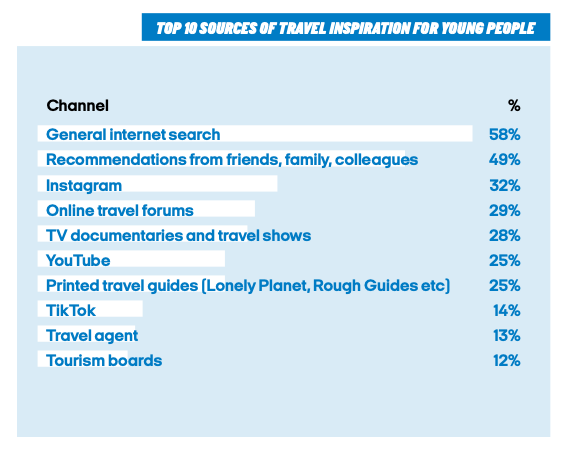
Source: Youth Travel Insight Report 2023, Kilroy
Word of mouth is also an important source of inspiration for the gap year market (49%). Personal recommendations have always been a great source of information, and word of mouth is more trusted these days than paid advertising. The increased use of influencer marketing for travel brands is a strong indicator of the power of peer-to-peer advertising. Influencer campaigns can be very useful to reach target audiences, establish authenticity and build awareness for your brand.
It is important that local tour operators use their websites and social media platforms effectively to inspire and attract the gap year market.
Tips:
- Assess the experiences you offer. Make sure they are authentic and immersive and include plenty of hands-on activities. Include detailed information about the experiences and lots of images and videos to inspire your audience.
- Make sure your experiences are sustainable. Tasks performed by volunteers should benefit the local community in a real way and not take work away from local people. The presence of volunteers should not have a negative impact on the environment.
- Use the CBI library of tourism studies to help develop your business strategy. Relevant studies you should use include How to work with influencers, How to be a sustainable tourism business, and How to be a successful company online.
Acorn Tourism Consulting Limited carried out this study on behalf of CBI.
Please review our market information disclaimer.
Search
Enter search terms to find market research
